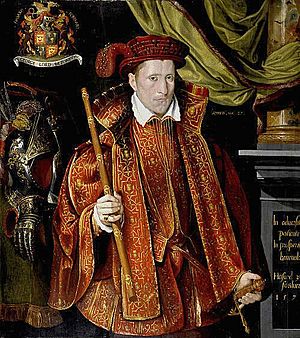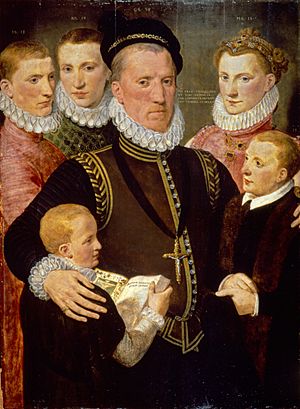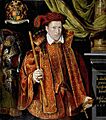George Seton, 7th Lord Seton facts for kids
Quick facts for kids
7th Lord Seton
George Seton
|
|
|---|---|

Portrait of George Seton
|
|
| Ambassador to France | |
| In office December 1583 – July 1585 |
|
| Provost of Edinburgh | |
| In office 1557–1561 |
|
| Personal details | |
| Born | 1531 |
| Died | 1586 France, Seton Collegiate Church (buried in Scotland) |
| Spouse | Isobel Hamilton |
| Children | 6, including Robert |
George Seton V, the 7th Lord Seton (1531–1586), was an important Scottish nobleman. He served as a member of the Scottish Parliament and was in charge of Queen Mary's household. He also held the role of Provost of Edinburgh, which was like being the mayor of the city.
George was the oldest son of George Seton, the 6th Lord Seton, and Elizabeth Hay. He spent his childhood and went to school in France.
Contents
George Seton's Political Journey
Edinburgh and the Reformation Era
George Seton became the Provost of Edinburgh in 1557. This meant he was the chief official of the city. He sometimes sent his carpenter, Robert Fender, to represent him at city council meetings.
In February 1558, George Seton was one of eight people chosen to go to Henry II of France. Their job was to arrange the marriage of Mary, Queen of Scots, to the French Prince, the Dauphin. The Scottish Parliament later confirmed that Seton and the others had done their job well. In 1559, the city council gave him money to host a big dinner for Mary of Guise, who was Mary, Queen of Scots' mother.
However, Seton and the city council soon faced problems. The Scottish Reformation was a time of big religious changes. In June 1559, Protestant leaders, called the Lords of the Congregation, took control of Edinburgh. Seton tried to protect the Blackfriars and Greyfriars monasteries, but he wasn't successful.
The Protestant Lords left Edinburgh in July. They made an agreement that allowed people to choose their religion. Seton and other leaders were asked to talk to the people of Edinburgh. They wanted to bring back the traditional church service, called the Mass, in St Giles Cathedral. But the people refused. They wouldn't allow Mass in any church.
When the Protestant Lords took Edinburgh again in October 1559, a new city council had already formed. Seton's council was put back in charge when the Protestants left. But when the English army arrived in April 1560, the new council was back in power.
During the Siege of Leith in 1560, Seton fought for Mary of Guise against the Scottish Protestants and the English army. He was captured by an English soldier but was saved by French soldiers. After the fighting ended, Seton sailed to France.
In Paris, in October 1560, he secretly met the English ambassador. Seton said he regretted fighting for Mary of Guise. He wanted to return to Scotland through England. Seton had a special payment from the French King. He planned to take a portrait of Queen Mary and a letter from her to Queen Elizabeth. But Mary's portrait wasn't ready. Seton left France in November 1560.
Supporting Mary in Scotland
When Mary returned to Scotland, George Seton showed his strong loyalty. He had a special message carved and gilded above the entrance to Seton Palace: "UN DIEU, UN FOY, UN ROY, UN LOY" (One God, One Faith, One King, One Law). This meant "One God for all time: One loyalty to the monarch."
Seton also had gold and silver medals made with the same message. They also had his initials and his wife's, Isobel Hamilton, and another motto: "Nemo Potest Duobus Dominus Servire" (No one can serve two masters).
In 1561, Mary tried to make Seton Provost of Edinburgh again, but it didn't work.
In March 1565, Seton fought a duel and badly injured another man. He went to France to avoid legal trouble. Seton returned to Scotland in October 1565. He brought weapons from France for Queen Mary. An English ship tried to stop him from docking, but it failed. Seton's cargo included three large horses for Mary's husband, Lord Darnley.
In November 1566, the French ambassador arrived in Edinburgh. Lord Seton escorted him to Stirling Castle for the baptism of Prince James.
After Lord Darnley's death in 1567, Mary was at Seton Palace. Seton and other supporters signed a document called the Ainslie Tavern Bond. This document supported Mary's marriage to James Hepburn, 4th Earl of Bothwell.
Mary stayed at Seton Palace before she was captured at the battle of Carberry Hill. She was then held prisoner at Lochleven Castle. She escaped to Seton's Niddry Castle, but her supporters were defeated again at the battle of Langside. Seton was taken prisoner. He was almost killed but was saved by James Stewart, 1st Earl of Moray.
Queen Mary went to England, and Seton's half-sister, Mary Seton, joined her. Seton was imprisoned in Edinburgh Castle. Mary worried he might get sick from the plague. Seton was eventually allowed to go to France.
Supporting the Exiled Queen
In August 1570, Seton was sent to the Duke of Alba in the Spanish Netherlands. He was acting as Mary's ambassador. Seton was to ask for Spanish help to put Mary back on the Scottish throne. He also wanted to get rid of her son's supporters, who relied on English power. The Duke of Alba sent money to help keep Edinburgh Castle under Mary's control.
A story says that Seton tried to convince Scottish soldiers fighting against Spain to switch sides. The soldiers didn't listen until Seton himself was captured and tortured. Then, the soldiers protested until he was released. The Duke of Alba offered money, but he couldn't send soldiers. So, Seton's mission was not successful.
In January 1572, Seton was still in the Spanish Netherlands. When he returned to Scotland through England, English ships searched Scottish vessels very carefully. There was even a plan to kidnap Seton when he arrived in Scotland, but it didn't happen.
In 1577, a man claimed there was a plot involving Seton and his sons. This plot, called the Ridolfi Plot, supposedly aimed to put Mary back on the Scottish throne. Seton was said to be involved in securing Edinburgh Castle for Mary.
In May 1579, Lord Seton and three of his sons were ordered to be held at Brechin Castle. Seton asked the King's guards to reduce their charge of treason. His son, John Seton of Barnes, was suspected of bringing messages from the exiled Queen Mary. In June 1581, Seton and two of his sons watched the execution of Regent Morton from a building in Edinburgh.
Ambassador in France, 1583
After a political event called the Gowrie Regime ended, Seton was sent as an ambassador to France in December 1583. He was joined by William Schaw, who was the King's Master of Works.
Seton wrote to Queen Mary from Seton Palace to explain his mission. He said he wanted to keep the old friendship between Scotland and France. He also wanted to follow the advice of the Duke of Guise and complete a plan for Mary to return to Scotland and rule with her son. Seton said serving Mary was his main goal. He also mentioned that King James was very poor and couldn't pay for his plans. Seton had to pay for the trip himself. The city of Edinburgh helped him by giving him money and a business task.
The English ambassador, Sir Edward Stafford, watched the Scottish embassy closely. Stafford noted Seton's meeting with the French king in February 1584. Stafford thought Seton spent a lot of money on entertaining. This made people suspect he was funded by Spain. Stafford also thought Seton's mission was about arranging a marriage for James VI.
By May 1584, Seton had run out of money. He had to pawn his silver dishes and the ship's guns. Seton asked Stafford about the rebel leaders who had fled to England. Stafford thought Seton was foolish for asking this.
In June 1584, Stafford noticed that Seton's words sounded like Mary, Queen of Scots. It was clear they talked often. James VI wrote to Mary in July, expecting Seton to return. After Seton came back to Scotland, a French diplomat wrote to James VI. He said Seton had worked hard to bring Mary and James VI together, but the time wasn't right. France wanted to stay friends with England.
Death and Memorial
Seton stayed in France until July 1585 or later. He died in February 1586. In June 1586, his son Alexander returned copies of papers about French import duties to the Edinburgh council. George was buried at Seton Collegiate Church. His memorial has a long Latin message that also describes his children's lives.
Family Life
George Seton married Isobel Hamilton (who died in 1604) in August 1550. She was the daughter of Sir William Hamilton of Sanquhar, who was in charge of Edinburgh Castle. Their wedding was a big celebration at Edinburgh Castle. Isobel's father helped rebuild Seton Palace, which had been damaged by the English army in 1544.
Lord Seton and Isobel Hamilton had several children:
- George, Master of Seton (died 1562)
- Robert Seton, 1st Earl of Winton
- Sir John Seton of Barnes, who worked for the Earl of Leicester and later for the King of Spain and James VI.
- Alexander Seton, 1st Earl of Dunfermline, a very important figure who became Lord Urquhart, Lord Fyvie, and Prior of Pluscarden.
- William Seton of Kylesmure, who married Janet Dunbar.
- Margaret Seton, who married Claud Hamilton, 1st Lord Paisley, in 1574. Their wedding was a grand event.
Isobel Hamilton was invited to serve Anne of Denmark at her coronation in May 1590. A Spanish report said that in 1592, Anne of Denmark told Isobel Hamilton and other ladies that she was Catholic. By December 1596, Lady Seton was said to be a great favorite of Anne of Denmark.
Lord Seton's Portraits
An old portrait of Lord Seton is now in the Scottish National Portrait Gallery. It shows him holding his staff, which was a symbol of his role as Master of Queen Mary's household. This painting might have been made later to remember him. It has a motto that says, "in adversity, unyielding; in prosperity generous." This matches a message seen under a version of the painting at Seton Palace. This portrait might have been painted by Adrian Vanson.
In 1582, a painter who worked for Lord Seton was paid for drawing the King's portrait for coins. This painter could have been Adrian Vanson or Arnold Bronckorst, who both painted portraits for James VI. Seton was also painted in a family group by Frans Pourbus the Elder. This painting is now in the National Gallery of Scotland.
An old writer described some of Seton's additions to Seton Palace. Above a fireplace, his coat of arms was carved. The ceiling of another room had 28 coats of arms of families from France, Scotland, and Lorraine. Someone also saw a painting on a wall at Seton Palace. They believed it showed Lord Seton driving a wagon during his time in exile in France.
Images for kids




